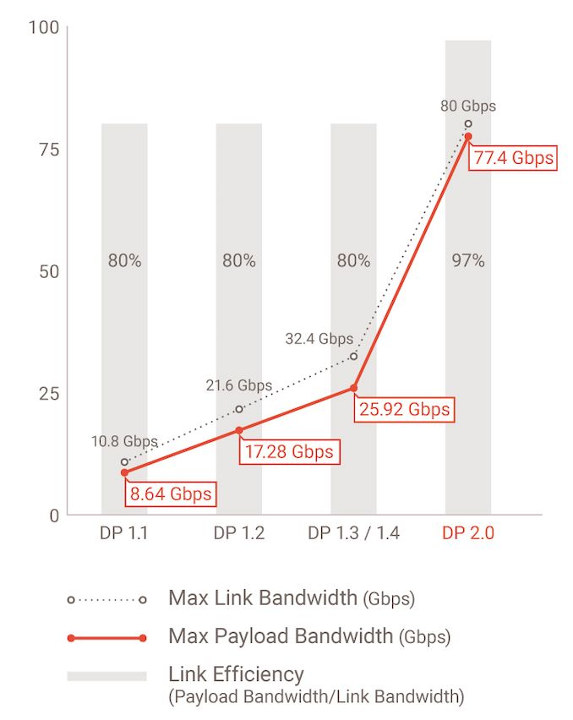4K monitors and TVs are now very common, and 8K displays, media players and camera are just coming to market and there’s still pretty expensive and content is basically nonexistent. 8K displays must be quite large or viewers must sit really close to get any benefit over 4K, but some people think 16K displays will be a thing in the not-to-distant future.
Announced in 2016, DisplayPort 1.4 took care of 8K 60Hz output thanks to a 32.4 Gbps link bandwidth and compression, but the Video Electronics Standards Association (VESA) has now announced DisplayPort 2.0 standard with support for one 16K display at up to 60 Hz, or two 4K displays at up to 144 Hz with HDR thanks to a 80 Gbps link bandwidth / 77.4 Gbps payload bandwidth.
DisplayPort 2.0 will work with either native DP connectors or USB Type-C connectors with DisplayPort Alt Mode for video and audio. DisplayPort 2.0 relies on Thunderbolt 3 physical interface (PHY) layer to achieve the higher bandwidth.
Beside the faster data rates, another interesting features of DisplayPort 2.0 is support for a display stream data mapping protocol common to both single-stream transport and multi-stream transport which will allow a single DP port on the source device to drive multiple displays either via a docking station or daisy-chainable displays.
Here are some of the new display configurations made possible by the new standard:
- Single display
- 16K (15360×8460) display @ 60Hz and 30 bpp 4:4:4 HDR (with DSC = Display Stream Compression)
- 10K (10240×4320) display @ 60Hz and 24 bpp 4:4:4 (no compression)
- Dual display
- 2x 8K (7680×4320) displays @ 120Hz and 30 bpp 4:4:4 HDR (with DSC)
- 2x 4K (3840×2160) displays @ 144Hz and 24 bpp 4:4:4 (no compression)
- Triple display
- 3x 10K (10240×4320) displays @ 60Hz and 30 bpp 4:4:4 HDR (with DSC)
- 3x 4K (3840×2160) displays @ 90Hz and 30 bpp 4:4:4 HDR (no compression)
- Multi-displays plus SuperSpeed USB data with two lanes on the USB-C connector used for DP Alt mode:
- 3x 4K (3840×2160) displays @ 144Hz and 30 bpp 4:4:4 HDR (with DSC)
- 2x 4Kx4K (4096×4096) displays (for AR/VR headsets) @ 120Hz and 30 bpp 4:4:4 HDR (with DSC)
- 3x QHD (2560×1440) @ 120Hz and 24 bpp 4:4:4 (no compression)
- 1x 8K (7680×4320) display @ 30Hz and 30 bpp 4:4:4 HDR (no compression)
The first products equipped with DisplayPort 2.0 (DP 2.0) are expected to launch at the end of 2020.
Via Liliputing and Anandtech

Jean-Luc started CNX Software in 2010 as a part-time endeavor, before quitting his job as a software engineering manager, and starting to write daily news, and reviews full time later in 2011.
Support CNX Software! Donate via cryptocurrencies, become a Patron on Patreon, or purchase goods on Amazon or Aliexpress





